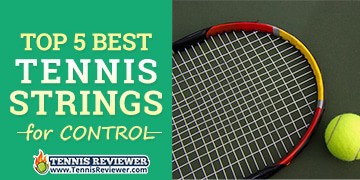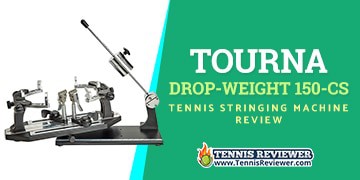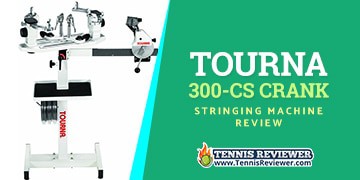Whether you are completely new to the tennis world or you are a seasoned player, most people don’t fully understand the different tennis string gauges and what they do to change the game. When looking at the racket, you may think that all strings look similar despite their colors. This simply is not true! They change in shape and thickness, which helps determine different factors when the ball comes off the string.
Depending on your level will depend on what gauge will be best for you. It also will depend on if you have any injuries, the type of string you are using, racket, and more. You may already be feeling overwhelmed but let this serves as your ultimate guide to different tennis string gauges.
Let’s get started.
Table of Contents
What is a tennis string gauge?
So, what is a tennis string gauge? The gauge refers to the thickness of the string. The thickness of a string will directly impact the way the ball comes off the strings. Gauge is measured in different members within a string. For instance, if you have the Solinco Hyper G, you can choose from 16, 16L, 17, and other gauges.
The numbers that determine the thickness in millimeters of the gauge are going to be different from the USA to European numbers. Similar to how shoe sizes work. The number system is different.
What Factors are Affected by Gauge?
When they place the string in their rackets, most players don’t realize the thinness has a direct impact on several factors. And those factors have a direct impact on the type of ball you are giving your opponent. This is why pros go down to the smallest detail.
The following areas that are most affected by the gauge are:
- Power
- Spin
- Durability
- Feel
From here, you can decide what factors need improvement and how to play on your strengths as a competitor.
Power
Some people are surprised to know that the thinner the string, the more power potential you have. It’s often interpreted that the bigger the string, the bigger the power, but in most cases, the thicker the string, the stiffer it is. When a string is thin and has a higher number in gauge, it contains more elasticity components. It also allows the strings to move more freely, which in turn allows for more ball-pocketing opportunities. The ball-pocketing can be thought of as like a slingshot. The strings get pulled back from the contact and slung forward. The more you can sling back and forth, the more power potential.
Spin
Spin is also something that comes with thinner strings. The more the strings can move around and snap back into place for the same reasons of power, the more spin potential the ball will have coming off the strings. Spin can be an incredibly important thing to have because if the power access is going to continue to reach new heights, you also need to access more spin. This is why the two and two go hand in hand. Thicker strings and a higher gauge don’t allow for the same potential but, in return, can offer some other benefits.
Durability
You may be thinking at this point, what would ever be the point in going lower in your string gauge rather than taking advantage of massive spin and power potential? Well, certain strings are going to cost much more than others. Natural gut could cost you $40 and up per one string package. If you have a thin string and a low gauge, you will be popping strings very quickly. The thicker the string and the higher the gauge, then you will get more bang for your buck as it will hold tension better and not wear down as quickly as a higher gauge would.
Feel
The feel of the ball is how it feels coming off the strings. This means how long it stays on the bed of the strings and the type of rotation you are going to get from the strings. This is directly related to power and spin. You can think of it as a result of the two.
Gauges and Specific Strings
While it would practically take an eon to go through what strings work best with their respective gauges, we can talk about certain string types that work well with gauges. While a lot of them focus on the 15-17 range strings that are naturally soft work well with a thicker string or lower gauge if possible. For instance, natural gut naturally breaks quickly (no pun intended).
A polyester string is a little tougher on the arm and would work well with a higher gauge and one that counteracts its toughness. Sometimes professionals and seasoned players will use a combination of strings to find a middle ground in stiff and power strings. The same can be done with different gauges.
What is the Chart?
So how is gauge really measured? And what are the common gauge ranges that players work with? There is not really a limit to where a manufacturer can make a string in terms of thickness or thinness, but they generally all stay within a specific range.
You will likely find most tennis strings to fall between 15L all the way up to 19 in gauge. Something that surprises people is actually that the higher the gauge number is, the thinner the string is. You also will not find that 19 gauge does not come at a 19L it ends at 19.
These are the exact metrics.
15L – 1.34mm – 1.40mm
16 – 1.29mm – 1.33mm
16L – 1.26mm – 1.28mm
17 – 1.23mm – 1.25mm
17L – 1.19mm – 1.22mm
18 – 1.13mm – 1.18mm
18L – 1.08mm – 1.12mm
19 – 1.02mm – 1.07mm
Most tennis players will stay in the 15-17 range as it offers durability and still some power and spin potentials. Plus, spin and power can come from other dynamics of the string-like texture, shape, material, and more.
In rare instances, we may see someone go up to the 19 because they have an extreme arm injury or are possibly a kid looking for more access to power that they can’t bring about on their own.
Frequently Asked Questions
Tennis string gauge isn’t something that everyone considers a priority, but it can really make a difference in the style of play. Sometimes it is not the string that you don’t love it’s actually just the wrong gauge for you. It may be too thick and not offering the power and spin a player needs. Or they could need the absolute opposite and more control, but the string gauge is too bouncy.
This brings up a lot of confusion for players. Because there are so many things to consider, lots of questions pop up that usually, a local pro may be able to help answer. However, a lot of it is seeing how you like things for yourself.
Here are some of the most frequently asked questions when it comes to string gauges.
How Do I Know Which Gauge is Right for me?
Figuring out what string gauge is right for you can take some time. The first step in the process is trying to figure out the string characteristics and whether the string is a good fit. All the metrics should balance each other out. So if you have a string that already produces a lot of spin because it has a lot of edges to its shape, then you don’t need a super thing string that provides a lot of spin.
On the contrary, if you are someone who needs more stability and control, a thicker string and a lower gauge are going to be really important for you. So how do you know what gauge is right for you? Most players stay between 15-17, but it may take some trial and error. The more often you are breaking strings, the more you will want to change the gauge, so the strings are thicker and more durable.
Should I Change my Gauge According to my Arm Pain?
Absolutely! When a player develops any kind of wrist or arm pain, it is always a good idea to see if you can switch things within the strings than switch out the racket. Stiffness is the name of the game when it comes to pain, so you want to try and loosen the stiffness up as much as possible. This means going with a higher gauge to provide more movement and less vibration.
Sometimes the gauge isn’t the issue. Sometimes a player works well with a specific gauge, but instead, the strong is a terrible fit. With there being so many different strings on the market from different manufacturers, it doesn’t hurt to try to swap out strings and test different things out.
Anything soft will help arm injuries.
What Gauge Do The Pros Use?
When we are looking at fantastic players like Serena Williams, Naomi Osaka, and Federer, among many more greats, we often like to replicate the things that they do. They are the geniuses, right? Well, while it is good to replicate some things, it’s important to remember your level in other areas.
You will find that most of the pros play with 16 and 16L, which rates high on the durability list. Because they are all such big power hitters and have developed their skills so well, they need thicker strings to hold up, or else they would break much too often and not hold tension very well.
Does the Gauge Matter with the Type of Racket You Use?
There are four different types of rackets that a player can choose to play with. They all produce many different results and are suited for specific types of players. While the string choice may be more important, the gauge certainly will matter as well. As we talked about, every little detail adds up. So if you play with a stiff racket and you need a little help with your strings, then you will choose a slightly higher gauge and a string that works well.
Everything needs to always counterbalance each other in the decision-making process so that it adheres to your strengths and protects your weaknesses as a player. A power racket will bode well with a thicker string, and a more traditional racket will work well with a higher gauge and thinner string. Modern and tweener rackets can adopt a mix of strings and the gauge because they act as a balance between all the categories like power, spin, and more.
Keep Adjusting
The more you get into tennis, the more things you will feel like you need to refine and fine-tune. While changing up your strings is always a great idea, it is a good idea to play with your gauge of string as well. The gauge is the thickness of your string and can help determine how much power you have and the level of spin you have. Some tennis players will need more control, and others will need less of it.
The gauge of a string will be marked by a number that is different in both the US and Europe. It’s based on how many millimeters of thickness. Figuring out which gauge is going to be perfect for you is going to take some trial and error. Most players stay between 15-17, and that includes the top professionals in the world like Nadal and Sharapova.
Something to keep in mind is that any injuries with the arm could use a gauge that is more arm-friendly. This means a thinner string that creates less vibration and has more absorption. Whatever you choose, be sure to keep all the factors in mind.











